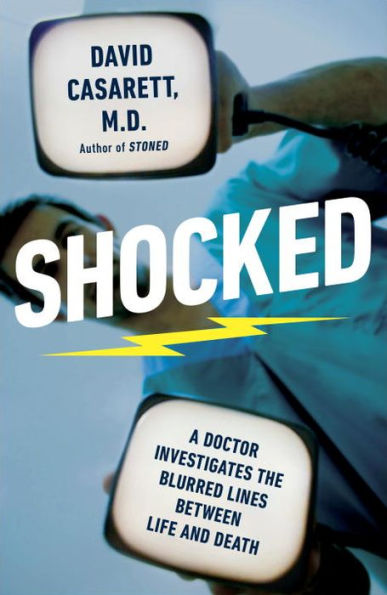Shocked: A Doctor Investigates the Blurred Lines Between Life and Death
As a young medical student, Dr. David Casarett was inspired by the story of a two-year-old girl named Michelle Funk. Michelle fell into a creek and was underwater for over an hour. When she was found she wasn’t breathing, and her pupils were fixed and dilated. But after three hours of persistent work, a team of doctors and nurses was able to bring her back.
If Michelle could come back after three hours of being dead, what about twelve hours? Or twenty-four? What would it take to revive someone who had been frozen for one thousand years? And what does blurring the line between "life" and "death" mean for society?
In Shocked, Casarett chronicles his exploration of the cutting edge of resuscitation and reveals just how far science has come. He takes us to a conference of "cryonauts" who want to be frozen after they die, a dark room full of hibernating lemurs in North Carolina, and a laboratory that puts mice into a state of suspended animation. The result is a spectacular tour of the bizarre world of doctors, engineers, animal biologists, and cryogenics enthusiasts trying to bring the recently dead back to life.
Fascinating, thought-provoking, and funny, Shocked is perfect for those looking for a prequel—and a sequel—to Mary Roach’s Stiff, or for anyone who likes to ponder the ultimate questions of life and death.
"1121999116"
If Michelle could come back after three hours of being dead, what about twelve hours? Or twenty-four? What would it take to revive someone who had been frozen for one thousand years? And what does blurring the line between "life" and "death" mean for society?
In Shocked, Casarett chronicles his exploration of the cutting edge of resuscitation and reveals just how far science has come. He takes us to a conference of "cryonauts" who want to be frozen after they die, a dark room full of hibernating lemurs in North Carolina, and a laboratory that puts mice into a state of suspended animation. The result is a spectacular tour of the bizarre world of doctors, engineers, animal biologists, and cryogenics enthusiasts trying to bring the recently dead back to life.
Fascinating, thought-provoking, and funny, Shocked is perfect for those looking for a prequel—and a sequel—to Mary Roach’s Stiff, or for anyone who likes to ponder the ultimate questions of life and death.
Shocked: A Doctor Investigates the Blurred Lines Between Life and Death
As a young medical student, Dr. David Casarett was inspired by the story of a two-year-old girl named Michelle Funk. Michelle fell into a creek and was underwater for over an hour. When she was found she wasn’t breathing, and her pupils were fixed and dilated. But after three hours of persistent work, a team of doctors and nurses was able to bring her back.
If Michelle could come back after three hours of being dead, what about twelve hours? Or twenty-four? What would it take to revive someone who had been frozen for one thousand years? And what does blurring the line between "life" and "death" mean for society?
In Shocked, Casarett chronicles his exploration of the cutting edge of resuscitation and reveals just how far science has come. He takes us to a conference of "cryonauts" who want to be frozen after they die, a dark room full of hibernating lemurs in North Carolina, and a laboratory that puts mice into a state of suspended animation. The result is a spectacular tour of the bizarre world of doctors, engineers, animal biologists, and cryogenics enthusiasts trying to bring the recently dead back to life.
Fascinating, thought-provoking, and funny, Shocked is perfect for those looking for a prequel—and a sequel—to Mary Roach’s Stiff, or for anyone who likes to ponder the ultimate questions of life and death.
If Michelle could come back after three hours of being dead, what about twelve hours? Or twenty-four? What would it take to revive someone who had been frozen for one thousand years? And what does blurring the line between "life" and "death" mean for society?
In Shocked, Casarett chronicles his exploration of the cutting edge of resuscitation and reveals just how far science has come. He takes us to a conference of "cryonauts" who want to be frozen after they die, a dark room full of hibernating lemurs in North Carolina, and a laboratory that puts mice into a state of suspended animation. The result is a spectacular tour of the bizarre world of doctors, engineers, animal biologists, and cryogenics enthusiasts trying to bring the recently dead back to life.
Fascinating, thought-provoking, and funny, Shocked is perfect for those looking for a prequel—and a sequel—to Mary Roach’s Stiff, or for anyone who likes to ponder the ultimate questions of life and death.
16.0
In Stock
5
1

Shocked: A Doctor Investigates the Blurred Lines Between Life and Death
272
Shocked: A Doctor Investigates the Blurred Lines Between Life and Death
272Paperback
$16.00
16.0
In Stock

Product Details
| ISBN-13: | 9781617230226 |
|---|---|
| Publisher: | Penguin Publishing Group |
| Publication date: | 10/13/2015 |
| Pages: | 272 |
| Product dimensions: | 5.45(w) x 8.36(h) x 0.70(d) |
| Age Range: | 18 Years |
About the Author
What People are Saying About This
From the B&N Reads Blog
